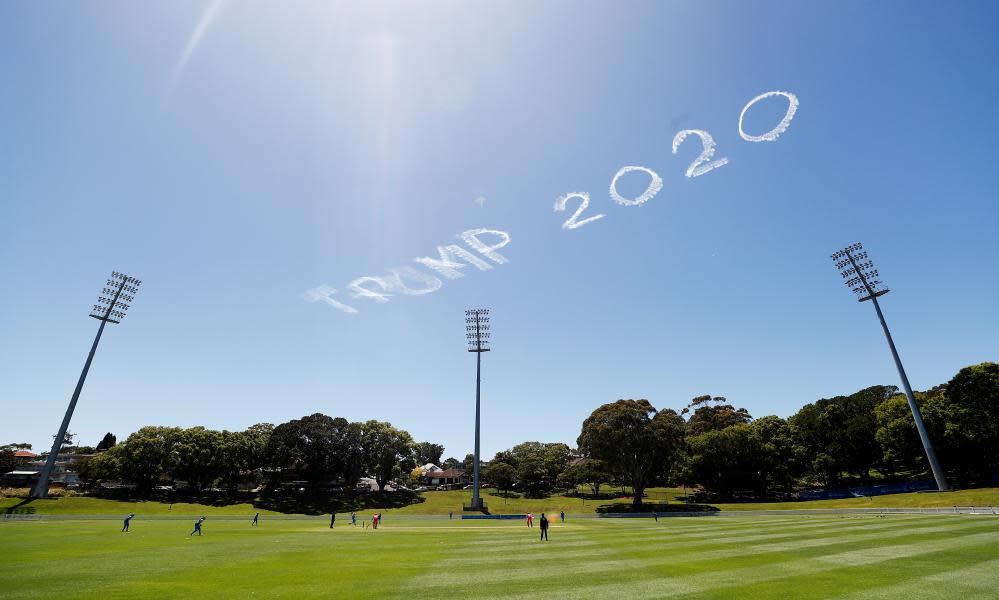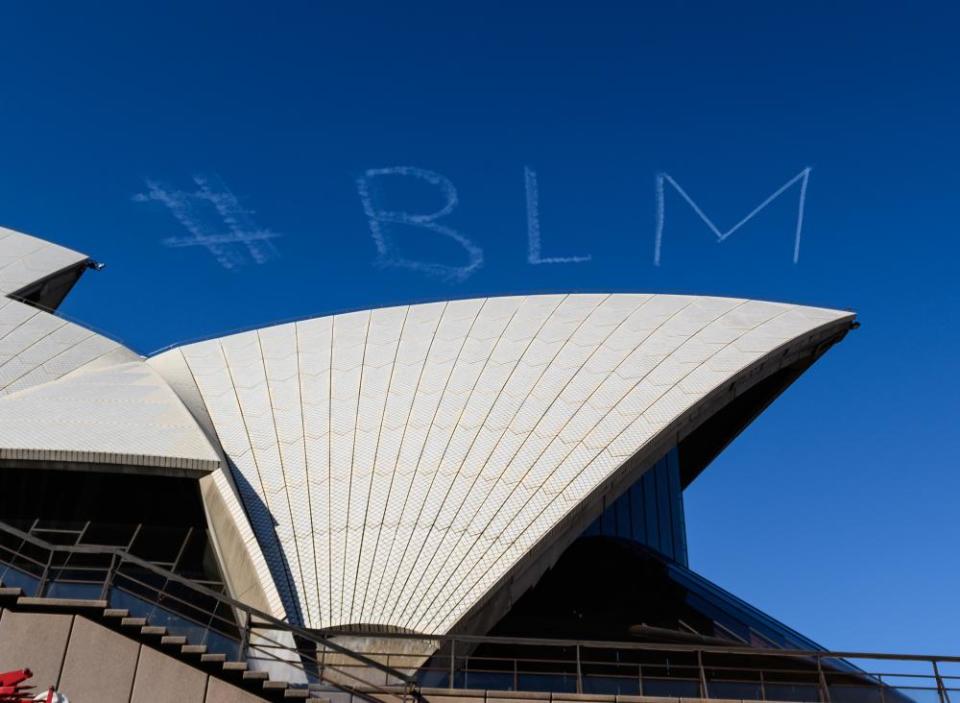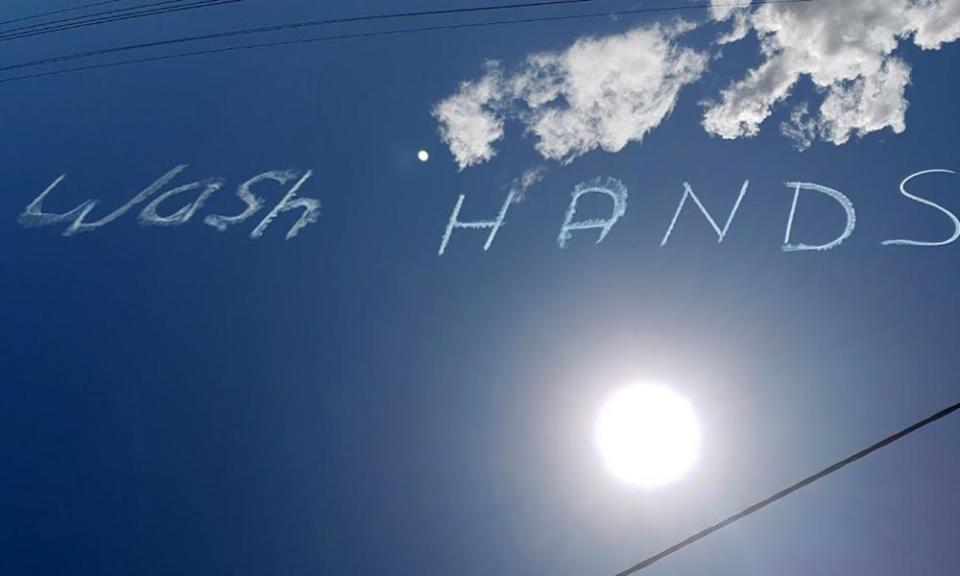Who owns Australia's sky and what can you actually write there?

Every year or so, a controversial message appears out of the blue.
In 2017 it was “Trump”. The name of the recently inaugurated president was scrawled over protesters at the Sydney Women’s March. Later that year it was “Vote No”, in opposition to the marriage equality bill. In 2019, as New South Wales debated legislation on abortion, the sky read “save unborn” and “choose life”.
This month “Trump 2020” was emblazoned on the sky, half a world away from where the defeated president was making false claims of voter fraud.
There are occasional progressive messages too. In June “#BLM” was written over Sydney as Black Lives Matter protesters took to the streets. But the conservative messages consistently draw the most public outrage. Photos are shared on social media, news stories are written and Skywriting Australia – which believes it is the nation’s only practicing commercial skywriting company – faces a deluge of complaints and abuse.

Skywriting requires a great degree of technical skill and it’s a rare craft; a United States-based skywriting firm recently told Vice there are “only six [full-time] skywriters in the world”.
Skywriting Australia takes on commissions from both private individuals and companies, and its rates start at $3,990 for a skywriting message, and $2,790 for an aerial banner. Skywriting Australia’s representative, who asked not to be named due to the volume of abuse he has received in the past, says his work is always commissioned by a third party, with the rare exception of birthday messages for friends.
“If anything happens, [people] always pounce on me,” he tells Guardian Australia.
If people have a problem with something on TV or radio, they can lodge a complaint with the Australian Communications and Media Authority. But if something’s written in 700-metre-tall letters above their homes, it’s not always clear where people should direct their complaints – or even who paid for the message.
“It’s like having your own little media,” the spokesperson for Skywriting Australia says, when asked about the company’s monopoly on commercial skywriting in Australia. “You’ve got quite a responsibility.”
‘Nobody owns the sky’
Michael Bradley, the managing partner at Marque Lawyers, explains: “The fundamental problem is that nobody owns the sky.
“Skywriting is not specifically regulated at all in Australian law,” he says. “However, it can be susceptible – at least in theory – to a range of laws governing public expression. It is a form of speech, just like any other.”
There are no restrictions on political messages. A 2018 act on voter communication gives the medium an explicit waiver to normal guidelines as, “due to the nature of skywriting, compliance … would be impractical”. It’s just not possible to stamp a message authorisation in the sky.
Skywriting advertisements (anything “promoting a product or service in a way which draws the attention of the public for a commercial purpose”) must comply with Ad Standards guidelines. Coca-Cola, for example, cannot drop c-bombs or make false claims in the sky.
But what about a private individual? While Australia has laws against swearing in public and hate speech, when asked if these apply to what’s written in the sky, official bodies couldn’t clearly direct Guardian Australia to whose department an incident of aerial obscenity would fall into.
Guardian Australia put questions to four state police services, all of which referred us to the Civil Aviation Safety Authority (Casa). Casa said it was “way outside [their] remit” as they only deal with aircraft safety requirements, then referred us back to state police.
NSW police did not provide an updated response. Both SA and Victoria police suggested that, if reported to police, an issue may be investigated in the same way as offensive graffiti. ACT police was hesitant to speculate as “we don’t usually deal in hypotheticals”.
“It’s a bit of a strange one,” an ACT police media spokesperson says, laughing.
In practice, it seems an individual can write whatever a skywriter will agree to.
“We can pretty much do anything, as long it’s not rude, crude or nasty,” the representative from Skywriting Australia says.
“[People] always want to do a cock and balls. It’s just not on.”
A matter of discretion
But refusing to draw a “cock and balls” is not the only time the company has used personal discretion about the work it will take on.
In 2017, after the “Vote No” controversy, Skywriting Australia rejected a request from marriage equality advocates who crowdfunded to write “Vote Yaaass” over Sydney.
The organiser claimed the pilot “refused and ‘wouldn’t do it for 50 grand’ - let alone 4,200”.
Related: Skywriting and skytyping could return to UK skies
Skywriting Australia confirms it refused the job, explaining the company received a barrage of abuse after the “Vote No” commission. “I just said ‘after the way your side’s treated me, I’m not doing anything’,” the company told Guardian Australia.
The social geographer Bradley Garrett, who has been following this subject for some time, pointed to this as an example of the need for outside regulation to protect against “political bias”.
“It occurred to me that the sky is a giant billboard,” he tells Guardian Australia. “Whether we’re talking about advertisements or political messages, or even declarations of love in the sky, there should be some sort of clearance process.
“As far as I know there’s only one person on the eastern seaboard who has been [writing the messages] ... He’s got a big billboard.”
The sky’s the limit
Skywriting has always been a powerful medium. In 1922 a pilot wrote a hotel phone number in the sky over Times Square; despite being visible for just a few minutes, it received more than 47,000 calls. From 1960 until this year, the practice was banned in the UK, in part due to its potential for spreading communist propaganda.
Today, that influence is compounded by its rarity and its “Instagrammable” nature. The messages are big enough and novel enough to cut through a crowded media cycle.
US artists and activists recently commissioned a huge sky-typing project that included the messages “Abolish ICE” and “Care not cages”.

In Australia, there have been a number of messages about the pandemic – many written on sky banners, instead of the sky itself. These are much smaller (usually around 1.5 metres high and 35 metres long) and offered by more companies, because they do not demand the same high level of technical ability that skywriting requires.
Aerial advertiser Sky-Ads flew a banner around Brisbane reading “Premier. Isolate North Qld now!”. It was commissioned by the federal MP Bob Katter. A Queensland man vowed to protest the premier’s border restrictions by flying a $1,800 banner reading “She is heartless” every week until the state election.
Garrett suggests this might become more common. He says that while drones are heavily regulated, “someone with the resources to fly a private jet can essentially do whatever they want”.
“We could end up with a situation where the sky is just cluttered with messages of all sorts,” Garrett warns. “And if there’s no regulation to deal with that beforehand it’s going to turn into a mess.” He suggests Casa could create a new branch to set the guidelines “that allow people to [share the space] in a way that’s not disrespectful to others”.


